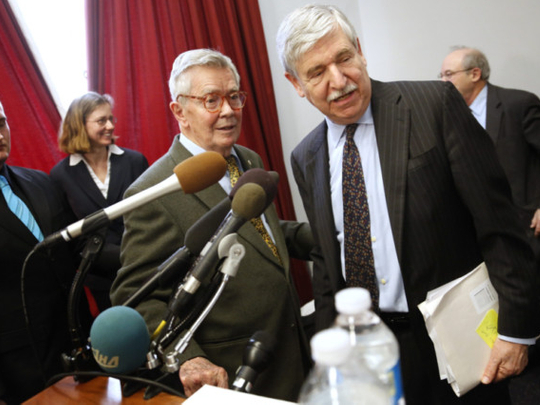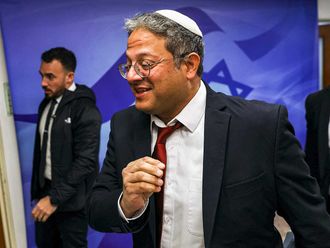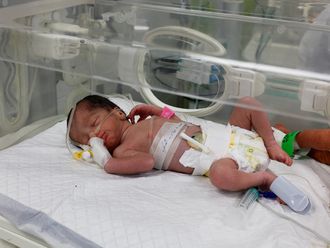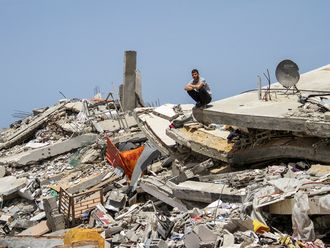
WASHINGTON - The United States and five other world powers signed an agreement with Iran over its controversial nuclear programme last weekend, a significant step toward resolving this years-long dispute. Iran says it wants to reduce international economic sanctions and, for purposes of its own national dignity, retain a right to a peaceful nuclear program. The six world powers want to restrict Iran’s ability to ever make a nuclear weapon. Some countries not at the talks - Israel and Arab Gulf states such as Saudi Arabia - want this too, although they think differently about it.
You can see right away how these two sets of goals might be tough to balance. An ideal agreement, from the view of the seven countries at the negotiations, would allow Iran to have a peaceful program in a way that completely reassures the outside world that it will be only peaceful. Last weekend’s deal is the negotiators’ best effort at achieving that balance. Israel and Arab Gulf states argue that the terms are too soft and that the best deal would not allow Iran to have any nuclear programme at all.
What follows is a candid assessment of “the good” from the deal, which is anything that moves all the parties toward their goals; “the bad,” anything that could risk those goals; and “the ugly,” the political and strategic complications that would make any diplomat want to pull out their hair.
THE GOOD
1. Iran has to roll back the most weapons-ready elements of its nuclear programme. It has to “neutralise” its stockpile of uranium that has been enriched to 20 per cent, which is not weapons grade but is close enough that it could be converted quickly. It has to dismantle any equipment that could be used to enrich uranium beyond 5 per cent.
2. Iran agreed to freeze many, but not all, of its nuclear activities. It can’t develop any uranium above 5 per cent enrichment (energy-grade uranium is enriched to 3.5 per cent). It can’t build more facilities or install more centrifuges. It also has to stop all work at the nuclear reactor under construction at Arak. Iran insists it is peaceful, but it is designed in a way that could make it efficient at producing plutonium.
3. The United Nations nuclear watchdog gets daily inspections. The International Atomic Energy Agency will visit the most sensitive sites every day and will install cameras to monitor the facilities remotely.
4. Iran gets access to $4.2 billion in its frozen overseas assets. That money will come in installments as Iran fulfills its commitments. Some sanctions will also be eased on Iranian trade, worth an estimated $1.5 billion. It’s a good-faith gesture meant to prove to Iran that cooperating is in its economic interest. This makes it easier for Iranian leaders to sell the deal at home.
5. Iran gets an implicit acknowledgment of a right to enrich. Iranian leaders have emphasised over and over that they want the world to acknowledge their sovereign right to enrich uranium, which they see as a show of their independence and national greatness. And past United Nations sanctions have ordered Iran to halt all enrichment. This deal does not explicitly say that the world recognises Iran’s right to enrich uranium. But it doesn’t deny it, either, and you’ll notice that it doesn’t forbid Iran from using some of its preexisting nuclear facilities or from developing uranium up to 5 per cent enriched.
6. China and Russia are on board. These two powers joined in signing the deal, along with the United States and Western European countries. That’s significant because Moscow and Beijing are more closely aligned with Tehran; they also both have a habit of breaking with Western powers. The fact that all these countries are on the same page makes it much easier to enforce the deal and to see it through.
THE BAD
1. It’s now more likely that the sanctions coalition could fall apart. For example, if China and Russia disagree with the United States and Europe over the next steps, or over whether Iran is holding to its end of the deal, then their unified front could collapse. It’s also possible that European leaders could split with the United States. In the worst case, Iran could renege and the international sanctions that the Obama administration worked so hard to put together could fall apart.
2. Speaking of Iran reneging, that could happen. A less comprehensive deal for Iran to halt all enrichment, signed in 2004, fell apart within about a year. Since then, Iran’s nuclear programme has grown considerably, including clandestine nuclear activities.
3. Israel and some Arab states worry it could be an Iranian ploy. They warn that Tehran could use this deal to weaken sanctions while continuing to develop its nuclear programme. If they’re right, that’s bad because this outcome would deepen the crisis. Even if they’re wrong, it’s still bad because their opposition makes the deal less viable. It also raises the possibility that they’ll take unilateral action against Iran, risking greater tension in the region.
4. Iran gets an implicit right to enrich. This one is listed under “the good” but it could also be bad because it drops the long-standing UN demand that Iran halt all enrichment. By implicitly giving that up, Iran is allowed to remain a step closer to a nuclear weapons programme. It would also be much tougher to reinstate that demand later on.
THE UGLY
1. The deal only lasts for six months. It’s interim, which is good in that the risks are lower if it falls apart, but also means that the negotiation process starts over almost immediately. This weekend’s deal addressed all of the key challenges, but it didn’t actually resolve anything since it expires in half a year.
2. A permanent version of this deal would be much tougher to make. The biggest hurdle may be United Nations sanctions. Western powers will probably want the UN Security Council to pass a new, temporary resolution every year or so “pausing” sanctions; that way, if they believe Iran is not holding to its end, sanctions will be easy to re-institute. The Iranian government, which sincerely fears that the West seeks its destruction, will likely object that this is insufficient assurance that the West will hold to its end and will insist that the UN repeal sanctions outright.
3. It could fall apart in Washington or Tehran. Sceptics in both capitals could try to scuttle the deal. The United States, for example, promised no new sanctions for six months; Congress is trying to pass new sanctions anyway. President Barack Obama will surely veto them, but Congress could win enough votes to overrule him, almost certainly killing negotiations. Tehran’s hardliners can get noisy as well. While Iran’s supreme leader, Ayatollah Ali Khamenei, appears to have blessed negotiations and is the ultimate authority, he’s also been reluctant at times to challenge internal hardliners. Groups such as the Revolutionary Guards could also quietly pressure Khamenei to renege on Iran’s pledges.
4. It doesn’t address other disputes with Iran. The United States will inevitably face a dilemma over its own sanctions, which are punishments not just for Iran’s nuclear program but for, among other things, its sponsorship of international terrorism. At some point, do the United States and Iran need to solve those issues as well to make a deal work?
5. It could reshape Middle East politics in unforeseen ways. Tension between the West and Iran has been a defining feature of the region since Iran’s 1979 revolution. If that tension eases, no one can say for sure what would happen to the region’s frail order - particularly given that opposition to Iran has long brought together Western power, Israel and Arab countries. If the deal goes forward, what will this mean for the troubled Israel-Palestine peace process? For the worsening relationship between the United States and Saudi Arabia? Between Israel and Europe? No one can say, and uncertainty is never welcome in the Middle East.
— Washington Post












